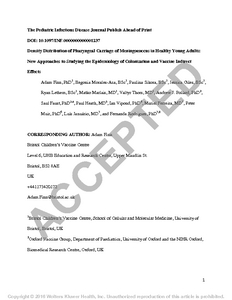Finn, A;
Morales-Aza, B;
Sikora, P;
Giles, J;
Lethem, R;
Marlais, M;
Thors, V;
Pollard, AJ;
Faust, S;
Heath, P;
et al.
Finn, A; Morales-Aza, B; Sikora, P; Giles, J; Lethem, R; Marlais, M; Thors, V; Pollard, AJ; Faust, S; Heath, P; Vipond, I; Ferreira, M; Muir, P; Januário, L; Rodrigues, F
(2016)
Density Distribution of Pharyngeal Carriage of Meningococcus in Healthy Young Adults: New Approaches to Studying the Epidemiology of Colonization and Vaccine Indirect Effects.
Pediatr Infect Dis J, 35 (10).
pp. 1080-1085.
ISSN 1532-0987
https://doi.org/10.1097/INF.0000000000001237
SGUL Authors: Heath, Paul Trafford
![[img]](https://openaccess.sgul.ac.uk/109896/1.hassmallThumbnailVersion/Density_Distribution_of_Pharyngeal_Carriage_of%25252097353.pdf)  Preview |
|
PDF
Accepted Version
Available under License ["licenses_description_publisher" not defined].
Download (690kB)
| Preview
|
Abstract
BACKGROUND: Improved understanding of Neisseria meningitidis (Nm) carriage biology and better methods for detection and quantification would facilitate studies of potential impact of new vaccines on colonization and transmission in adolescents. METHODS: We performed plate cultures on 107 oropharyngeal swabs stored frozen in skim milk tryptone glucose glycerol (STGG) broth and previously positive for Nm. We compared quantitative polymerase chain reaction (qPCR) detection of Nm in 601 STGG-swabs with culture. Using qPCR (n = 87), a log-phase broth culture standard curve and semiquantitative plate cultures (n = 68), we measured density of carriage. We compared qPCR genogrouping of DNA extracts from STGG-swabs and from plate culture lawns (n = 110) with purified isolates (n = 80). RESULTS: Swab storage resulted in only 10% loss of culture sensitivity. Direct sodC qPCR Nm detection yielded more positives (87/601, 14.5%) than culture (80/601, 13.3%). Most samples (57/110) positive by culture were also positive by qPCR and vice versa, but discrepancies (single positives) were frequent among low-density samples. sodC qPCR was positive in 79/80 isolates but in only 65 by ctrA qPCR. Density both by culture and qPCR varied across 4 orders of magnitude with the majority being low (<50 bacteria-gene copies/mL) and a minority being high (>1000). Genogrouping qPCRs yielded more positive results when performed on DNA extracts from lawn cultures. CONCLUSIONS: We provide the first description of the distribution of Nm carriage density. This could be important for understanding transmission dynamics and population-level effectiveness of adolescent vaccine programs. Storage of swabs frozen in STGG for batched laboratory analysis facilitates carriage studies and direct sodC qPCR for Nm combined with qPCR genogrouping of lawn culture extracts provides accurate, detailed description of colonization.
| Item Type: |
Article
|
| Additional Information: |
This is a non-final version of an article published in final form in Finn, A; Morales-Aza, B; Sikora, P; Giles, J; Lethem, R; Marlais, M; Thors, V; Pollard, AJ; Faust, S; Heath, P; et al. Density Distribution of Pharyngeal Carriage of Meningococcus in Healthy Young Adults: New Approaches to Studying the Epidemiology of Colonization and Vaccine Indirect Effects. Pediatr Infect Dis J, 35 (10). pp. 1080-1085 |
| Keywords: |
Adolescent, Adult, Bacterial Typing Techniques, Carrier State, Child, Humans, Meningitis, Meningococcal, Neisseria meningitidis, Pharynx, Polymerase Chain Reaction, Sensitivity and Specificity, Young Adult, Neisseria meningitidis, carriage, carriage density, young adults, molecular detection, Pediatrics, 1114 Paediatrics And Reproductive Medicine |
| SGUL Research Institute / Research Centre: |
Academic Structure > Infection and Immunity Research Institute (INII) |
| Journal or Publication Title: |
Pediatr Infect Dis J |
| ISSN: |
1532-0987 |
| Language: |
eng |
| Dates: |
| Date | Event |
|---|
| October 2016 | Published | | 25 May 2016 | Published Online | | 21 March 2016 | Accepted |
|
| Publisher License: |
Publisher's own licence |
| PubMed ID: |
27228196 |
| Web of Science ID: |
WOS:000384125600005 |
 |
Go to PubMed abstract |
| URI: |
https://openaccess.sgul.ac.uk/id/eprint/109896 |
| Publisher's version: |
https://doi.org/10.1097/INF.0000000000001237 |
Statistics
Item downloaded times since 13 Jun 2018.
Actions (login required)
 |
Edit Item |



